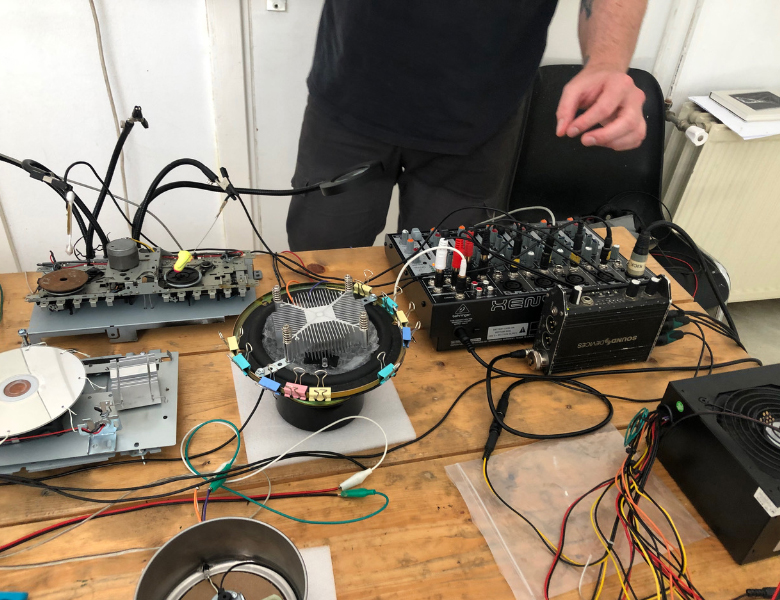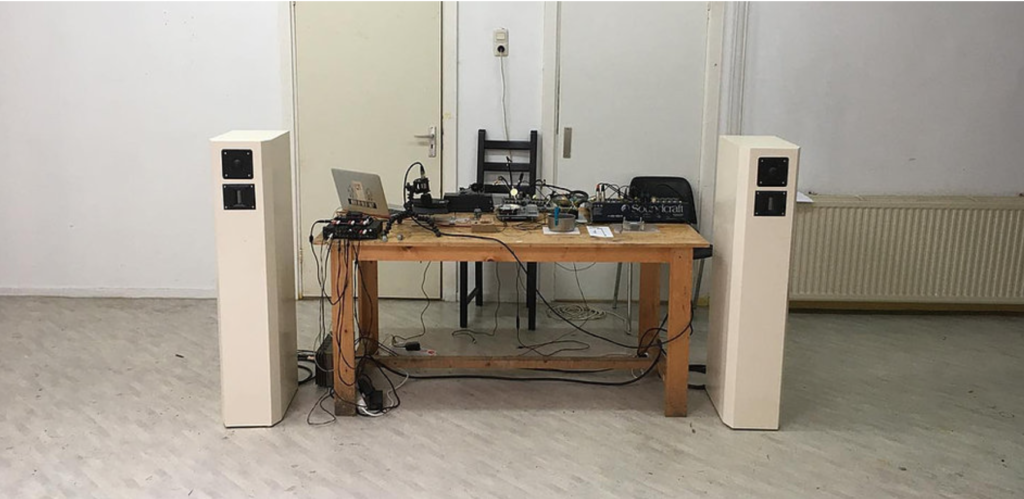 Agenda
Artikelen
Programma
Agenda
Artikelen
Programma

Since 2005 Simon Whetham (UK, b. 1970) has developed an artistic practice of working with sonic activity as a raw material for creation. By using environmental sound, employing a variety of methods and techniques he obtains often unnoticed and obscured sound phenomena. The final result ends up as a performance or installation, where the space and the objects within become instruments to be played. From 17 May to 25 July 2021 he is doing a residency at Witte Rook Breda.

Linda Köke: ‘Before you arrived at Breda, you also worked remotely as part of the residency, in preparation for your physical arrival. What did you research these weeks in your hometown?’
Simon Whetham: “I started my residency online in my hometown Marseille, France. I collected sounds from Marseille, to utilise them in the activation of objects found or donated in both locations. Two sounds that I am using in the presentation in Breda, are the sounds of a ferry set in the port, and traffic passing by in a tunnel, both recorded at home. Both have very low frequencies, coming from the motors of the ship and the cars. These deep sounds tend to make things move. I layered these two sounds, just slightly out of synchronisation. These are the basis of the installation that I have made here in Breda. I also recorded my remote process online in blog posts, where I share my work process and meetings with Dutch musicians in Brabant such as Bart van Dongen and Rogier Telderman.’’
LK: “So what does the presentation here at Witte Rook consist of?”
SW: “The combination of sounds I recorded in Marseille powers different kinds of motors, which bring objects into motion, thus creating another sound. I gathered these small motors from all sorts of devices, like printers, CD players or computers. I built small sound sculptures from all sorts of materials that can produce more sounds themselves. One of the more delicate ones is a small motor, hardly an inch big, hanging on the wall. The frequency of the sound causes the motor to move, and as a result tick against the wall. The original sounds are now being transformed into a completely different sound, via the intermediate step of movement.
I also used for instance a heat sink, which is usually attached to a computer’s circuit board. It is made of metal sheets of different lengths; so when wind blows at it, you hear different notes. During an earlier residency in Switzerland I also experimented with a turntable, but now I made an improvised version of one. It consists of two plant saucers with a belt from a printer moving it. If you put any objects on it, it then creates more sounds that I can capture and let the audience hear. There is also a piece inspired by a Tibetan singing bowl. If you go to any experimental music event, there’s almost always one person playing this instrument. I’m kind of making a bit fun of that, I like doing that.”
LK: “How does the work you are creating here relate to your broader practise?”
SW: “In my previous live work I place speakers or sound-making objects around the room. The sounds they made were quite subtle: it just makes it a lot more interesting for the audience. I’ve been doing this kind of work now for about ten years. It’s always changing and developing, to the point where I stopped using big speakers and I was just using the sounds of the room and the objects in it. But after ten years I already know roughly what I can and can’t do, and it’s very limited in some places, like outdoors. So therefore I then started concentrating more on motors and installation works, which are more sculptural. This is the stage where I am now.
There is the general tendency in my practise that the work is not just about the sounds, but about the space as well. You kind of forget that you’re sat in this space. Sometimes things happen, like the door will open and close or the ticking of a branch on the window, that make you question what sounds are my doing and what sounds are coincidental from the surroundings.”
LK: “Would you describe your works more as sound piece, installations or something completely different?”
SW: “The way I am doing it now at Witte Rook, is more a performance. I arrange things myself, use a mixer board to react to the sounds; when something starts to die down, or starts up again, I put a microphone there and amplify the thing as well. The sounds all have their own character and I treat them in different ways.”
LK: “So it’s very playful: as the performer you can tailor the sound scape to whomever is in the room experiencing it.”
SW: “It really is. It’s so much fun to see people’s reaction to unexpected sounds. This playfulness is very important to me too in the creating of these works. Since I started working with motors and devices, I learned much more about it and I still remember a lot of it from school. I am not a scientist however; I don’t want to know too much, because I still like being surprised and discovering. Knowing that I can’t do something can be very limiting in experimenting with things, there’s no fun in that.”